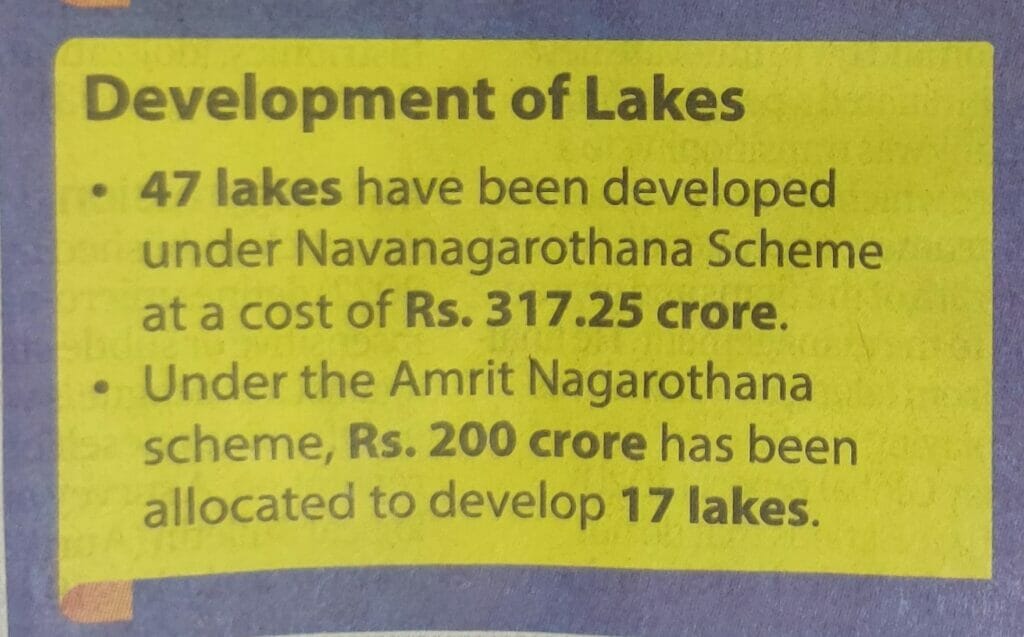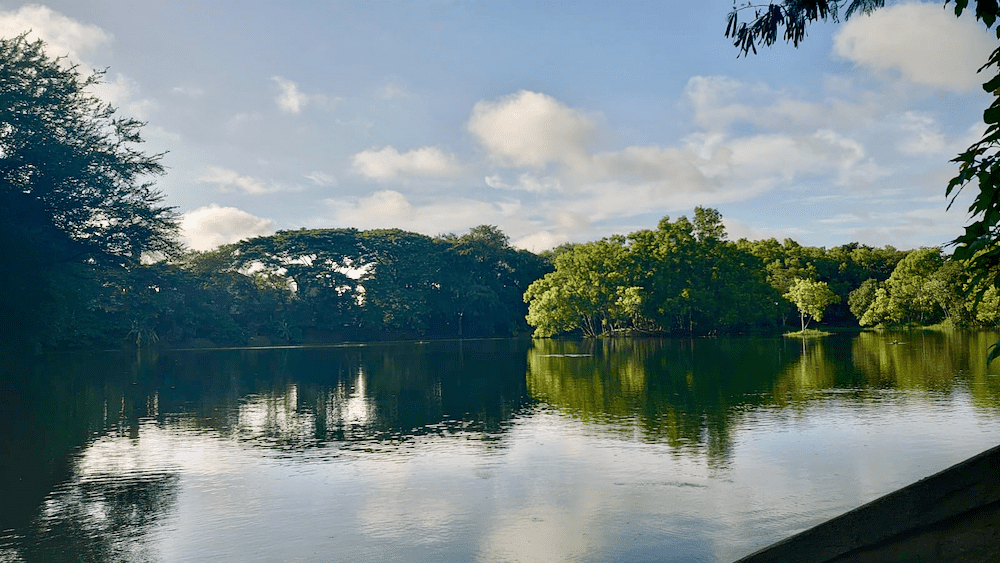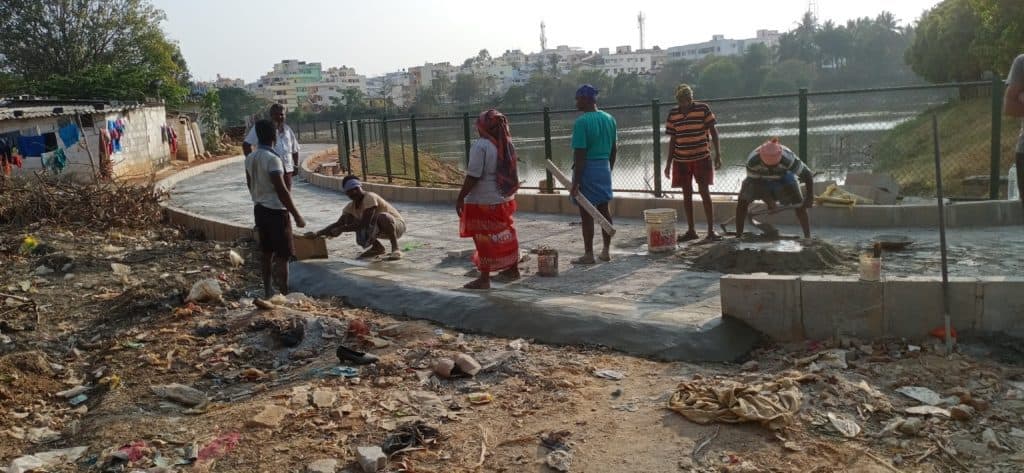Editor’s note: On January 25 2022, the state government put out a full page ad in the Deccan Herald showcasing its achievements in Bengaluru. The ad praised the government’s expenditure of hundreds of crores spent on restoring lakes, building BBMP schools, the much publicised Namma clinics, roads, and various BDA layouts. In the upcoming series, we look at some of these claims and see the reality behind it.
On January 25th, the state government claimed in an advertisement that “47 lakes had been developed under the Nava Nagarothana scheme at the cost of 317.25 crores.”
Under the Amrutha Nagarothana scheme, another Rs 200 crores were sanctioned for 17 new lakes to be restored. The advertisement makes it seem fairly straightforward–the government has spent close to Rs 500 crores restoring our lakes.
In reality, the city’s lakes are receiving piecemeal funds leading to work being done in a stop-start fashion. Moreover, concerned citizens have no way of actually understanding how the lakes were going to be restored.
The lack of transparency has led to many Bangaloreans fearing that the restoration works were merely superficial fixes that were at best a waste of public funds and at worst going to end up destroying lake habitats. Worse, some citizens allege that renovation plans are an excuse to reduce the size of the lakes and encroach upon them.
Read more: No new allocations under Nagarothana scheme in current BBMP budget
Claims made in the advertisement
The Nava Nagarothana scheme is an urban development grant that was first fashioned by former CM Siddharammaiah. The scheme was called Nava Bengaluru at that time. HD Kumaraswamy also allotted a large grant through this scheme in 2019. When the BJP came to power after the political crisis in June 2019, it was renamed the Nava Nagarothana scheme.
Advertisements put out by the Department of Information and Public Relations claimed that Rs 317.25 crore had been spent to develop 47 lakes under the Nava Nagarothana scheme in 2021. However, this is not entirely accurate. Officials at the BBMP Lakes department explained that all the lakes were still in varying phases of development.

Moreover, the Urban Development Department’s (UDD) Annual report (2021-22) shows that Rs 317.25 crore was allocated for 47 works, based on the budgetary allocations of the fiscal year 2019-2020 under the Kumaraswamy government. Of this, roughly Rs 88 crores were given to the Yelahanka, Bommanahalli, and RR Nagar zones. The remaining Rs 229 crores were allocated to the lake works.
It is important to note that 47 works is not the same as 47 lakes. Works can include multiple activities in the same lake. For instance, fencing and desilting are two works that are routinely carried out as part of lake development.
In fact, a UDD government order approving lake work dated September 2019, shows that the Nava Nagarothana amount and additional funds was spread across works for 59 lakes.

The advertisement also claimed Rs 200 crores had been allocated to develop 17 new lakes in 2022 under the Amrutha Nagarothana scheme. The Amrutha Nagarothana scheme is yet another urban development grant this time fashioned under the Basavaraj Bommai led BJP government in 2022.
A UDD government order approving BBMP expenditure (dated June 18 2022) shows that Rs 200 crores were allocated for rejuvenation work in 67 lakes.
Although the state government claims that 47 lakes were fully developed under the Nava Nagarothana Scheme, the BBMP lakes department could not confirm which lakes had actually been completed. Moreover, at least 10 lakes, which were being developed under the Nava Nagarothana scheme, were also being developed under the Amrutha Nagarothana scheme.
Piecemeal funding and work
This is because lakes are rarely developed in one go, according to Nithya, executive engineer (Lakes) for the BBMP Central Zone. Money required for lake management or any other activity by the BBMP is rarely given in full. UDD disburses it at different times.
For instance, UDD broke up the Rs 229 crores meant for lakes under the Nava Nagarothana scheme into 15 packages or installments and disbursed it at different times. This money is then distributed to different zones. The zonal lake officials then decide which lakes to develop based on the amount available and urgency, Nithya explains.
Despite the claims of the government advertisement, this piecemeal approach means that 47 lakes had not been completely developed. Rather, several lakes had undergone the first phase of development, according to Vijay Haridas, the BBMP Chief Engineer for Lakes. Phase 1 includes basic works such as desilting, bund formation, sewage diversion and fencing to prevent encroachment. Phase 2 included works like pathway improvements.
The 17 lakes mentioned under the Amrutha Nagarothana scheme in the advertisement were being developed for the first time. Among the remaining 50 lakes, some were spillovers from work undertaken in 2021, according to the chief engineer.

Inexplicable delays
Moreover, the entire chronology from the Chief Minister’s budget speech to when lake restoration work actually begins, suggests major delays in the process.
For instance, the allocations under the Nava Nagarothana scheme were announced by the HD Kumaraswamy government as part of the 2018-2019 budget. The BJP took over in July 2019 and the UDD approvals came in September 2019.
Yet, some of these lakes which were approved are only being worked on this year. For instance, Saul Kere in the Mahdevapura zone and the controversial Hosakerehalli lake in the RR Nagar zone were approved in September 2019. The work appears to have begun in January 2023, a few months before elections.
Read more: Hosakerehalli lake left in limbo

This piecemeal approach and delays make it difficult to monitor how much work is actually completed in a lake. This has led to accusations of lack of transparency and widespread corruption by citizen groups. We will explore this in Part 2.
What the Government says is VERYMUCH true in the RECORDS, and the CLAIMED SPENT money has VANISHED from the exchequer of the Government.
Definitely it would have reached the POCKETS of officials, politicians, contractors, middlemen etc. That’s the reason BBMP is NOT in a position to give any clarification of the claim, which has been PROPAGATED through SIGN BOARDS.